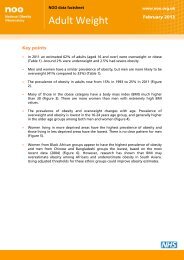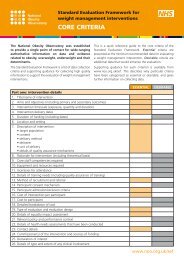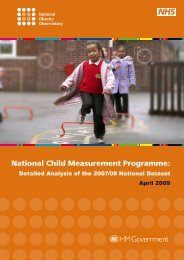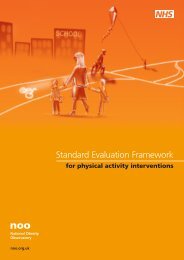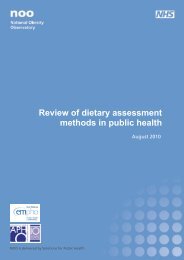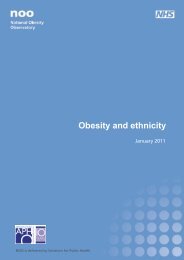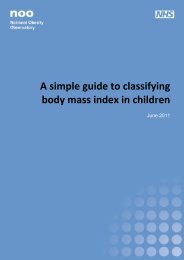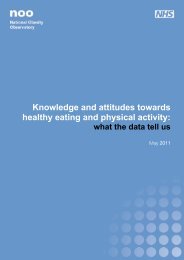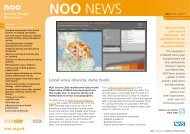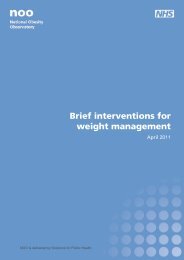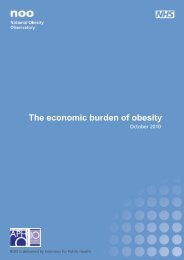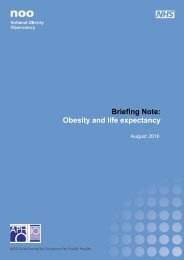Measures of central adiposity as an indicator of obesity - National ...
Measures of central adiposity as an indicator of obesity - National ...
Measures of central adiposity as an indicator of obesity - National ...
You also want an ePaper? Increase the reach of your titles
YUMPU automatically turns print PDFs into web optimized ePapers that Google loves.
<strong>Me<strong>as</strong>ures</strong> <strong>of</strong> Central<br />
Adiposity <strong>as</strong> <strong>an</strong> Indicator<br />
<strong>of</strong> Obesity:<br />
<strong>Me<strong>as</strong>ures</strong> <strong>of</strong> <strong>central</strong> <strong>adiposity</strong><br />
<strong>as</strong> <strong>an</strong> <strong>indicator</strong> <strong>of</strong> <strong>obesity</strong><br />
August 2009
Executive summary<br />
Obesity h<strong>as</strong> long been identified <strong>as</strong> <strong>an</strong> import<strong>an</strong>t risk factor for a number <strong>of</strong><br />
health problems. Body M<strong>as</strong>s Index (BMI), the most frequently used me<strong>as</strong>ure to<br />
determine levels <strong>of</strong> body fat, provides a proxy me<strong>as</strong>ure <strong>of</strong> total <strong>adiposity</strong> (the<br />
amount <strong>of</strong> fat around the body), but a number <strong>of</strong> studies have suggested that<br />
the accumulation <strong>of</strong> body fat around the waist (<strong>central</strong> or abdominal <strong>adiposity</strong>)<br />
may present a higher risk to health th<strong>an</strong> fat deposited in other parts <strong>of</strong> the<br />
body.<br />
High levels <strong>of</strong> <strong>central</strong> <strong>adiposity</strong> in adults are known to be <strong>as</strong>sociated with<br />
incre<strong>as</strong>ed risk <strong>of</strong> <strong>obesity</strong>-related conditions including type 2 diabetes,<br />
hypertension <strong>an</strong>d heart dise<strong>as</strong>e. Although me<strong>as</strong>ures <strong>of</strong> <strong>central</strong> <strong>adiposity</strong> are<br />
closely correlated with BMI, they have been shown to predict future ill health<br />
independently <strong>of</strong> BMI.<br />
The best evidence to date suggests that me<strong>as</strong>ures <strong>of</strong> general <strong>an</strong>d <strong>central</strong><br />
<strong>adiposity</strong> should be used together in order to best identify individuals at<br />
incre<strong>as</strong>ed risk <strong>of</strong> <strong>obesity</strong>-related ill health.<br />
It is not clear from the research published to date what constitutes the best<br />
me<strong>as</strong>ure <strong>of</strong> <strong>central</strong> <strong>adiposity</strong> in terms <strong>of</strong> predicting ill health or mortality, <strong>an</strong>d<br />
this may differ by age, sex, ethnicity, or by the dise<strong>as</strong>e being studied. Waist<br />
circumference h<strong>as</strong> been most frequently investigated in the published literature<br />
<strong>an</strong>d, given that this me<strong>as</strong>ure is more e<strong>as</strong>ily recorded <strong>an</strong>d interpreted th<strong>an</strong><br />
alternatives such <strong>as</strong> weight-to-hip or weight-to-height ratios, this currently<br />
seems to be the most appropriate option among me<strong>as</strong>ures <strong>of</strong> <strong>central</strong> <strong>adiposity</strong><br />
for most public health purposes.<br />
The World Health Org<strong>an</strong>ization (WHO) h<strong>as</strong> advised that <strong>an</strong> individual’s relative<br />
risk <strong>of</strong> <strong>obesity</strong>-related ill health c<strong>an</strong> be more accurately cl<strong>as</strong>sified using both BMI<br />
<strong>an</strong>d waist circumference th<strong>an</strong> by either alone. WHO h<strong>as</strong> developed a set <strong>of</strong><br />
thresholds to categorise <strong>an</strong> individual’s risk <strong>of</strong> <strong>obesity</strong>-related illness b<strong>as</strong>ed on<br />
BMI <strong>an</strong>d waist circumference. The <strong>National</strong> Institute for Health <strong>an</strong>d Clinical<br />
Excellence (NICE) h<strong>as</strong> also endorsed these thresholds for use in the UK. Using the<br />
WHO cl<strong>as</strong>sification, over 50% <strong>of</strong> both men <strong>an</strong>d women in Engl<strong>an</strong>d were at<br />
incre<strong>as</strong>ed risk <strong>of</strong> <strong>obesity</strong>-related ill health, according to the Health Survey for<br />
Engl<strong>an</strong>d (HSE) 2007.<br />
People <strong>of</strong> South Asi<strong>an</strong> origin seem more prone to carrying excess fat <strong>central</strong>ly<br />
th<strong>an</strong> the White population <strong>an</strong>d show raised <strong>obesity</strong>-related risk at lower BMI<br />
<strong>an</strong>d lower waist circumference levels. Therefore it is particularly import<strong>an</strong>t for<br />
South Asi<strong>an</strong> populations in the UK to be aware <strong>of</strong> the health risks <strong>of</strong> incre<strong>as</strong>ed<br />
waist circumference.<br />
NOO │ MEASURES OF CENTRAL ADIPOSITY AS AN INDICATOR OF OBESITY 1
In terms <strong>of</strong> population monitoring, BMI h<strong>as</strong> some adv<strong>an</strong>tages over me<strong>as</strong>ures <strong>of</strong><br />
<strong>central</strong> <strong>adiposity</strong>. It involves less physical contact, <strong>an</strong>d height <strong>an</strong>d weight c<strong>an</strong> be<br />
more reliably me<strong>as</strong>ured th<strong>an</strong> waist circumference following b<strong>as</strong>ic training;<br />
me<strong>as</strong>uring waist circumference reliably requires more extensive training. BMI is<br />
the most commonly used me<strong>as</strong>ure in national <strong>an</strong>d international <strong>obesity</strong><br />
prevalence statistics <strong>an</strong>d so is most useful for historical trend <strong>an</strong>alyses <strong>an</strong>d<br />
international comparisons. Making more use <strong>of</strong> me<strong>as</strong>ures <strong>of</strong> <strong>central</strong> <strong>adiposity</strong><br />
would further our underst<strong>an</strong>ding <strong>of</strong> the epidemiology <strong>of</strong> <strong>obesity</strong>.<br />
Why are we interested in me<strong>as</strong>ures <strong>of</strong> <strong>central</strong> <strong>adiposity</strong>?<br />
BMI is a me<strong>as</strong>ure <strong>of</strong> weight (for height) rather th<strong>an</strong> a me<strong>as</strong>ure <strong>of</strong> body fat.<br />
Excess fat, rather th<strong>an</strong> excess weight, is linked to <strong>obesity</strong>-related ill health.<br />
Furthermore, BMI does not describe where fat is deposited, <strong>an</strong>d <strong>as</strong> intraabdominal<br />
fat is thought to be more likely to cause ill health th<strong>an</strong> fat deposited<br />
in other parts <strong>of</strong> the body, me<strong>as</strong>ures such <strong>as</strong> waist circumference have some<br />
obvious adv<strong>an</strong>tages.<br />
There are well documented links between high levels <strong>of</strong> <strong>central</strong> <strong>adiposity</strong> in<br />
adults, <strong>as</strong> me<strong>as</strong>ured by waist circumference, waist-to-height or waist-to-hip<br />
ratio, <strong>an</strong>d risk <strong>of</strong> <strong>obesity</strong>-related conditions including type 2 diabetes,<br />
hypertension <strong>an</strong>d heart dise<strong>as</strong>e. These links remain even once BMI is adjusted<br />
for, demonstrating that me<strong>as</strong>ures <strong>of</strong> <strong>central</strong> <strong>adiposity</strong> are independent<br />
predictors <strong>of</strong> future <strong>obesity</strong>-related ill health.<br />
There is also <strong>an</strong> incre<strong>as</strong>ing body <strong>of</strong> evidence to show that such me<strong>as</strong>ures <strong>of</strong><br />
<strong>central</strong> <strong>adiposity</strong> are also effective predictors <strong>of</strong> ill health for children.<br />
What is the nature <strong>of</strong> the evidence for the use <strong>of</strong> <strong>indicator</strong>s <strong>of</strong><br />
<strong>central</strong> <strong>adiposity</strong>?<br />
The Europe<strong>an</strong> Prospective Investigation into C<strong>an</strong>cer <strong>an</strong>d Nutrition (EPIC), 1 a large<br />
scale, prospective cohort study involving nearly 360,000 particip<strong>an</strong>ts from nine<br />
Europe<strong>an</strong> countries, provides some <strong>of</strong> the best evidence to date <strong>of</strong> the<br />
relationship between <strong>central</strong> <strong>adiposity</strong> <strong>an</strong>d future ill health. This study<br />
concluded that both general <strong>adiposity</strong> <strong>an</strong>d <strong>central</strong> <strong>adiposity</strong> are independently<br />
related to the risk <strong>of</strong> death <strong>an</strong>d should be used together to identify individuals<br />
at risk <strong>of</strong> <strong>obesity</strong>-related ill health.<br />
Waist circumference <strong>an</strong>d BMI were found to be closely correlated <strong>an</strong>d both show<br />
a similar <strong>an</strong>d strong <strong>as</strong>sociation with the risk <strong>of</strong> death. Waist-to-hip ratio w<strong>as</strong><br />
found to be less closely correlated with BMI, though still <strong>as</strong>sociated with the risk<br />
<strong>of</strong> death. Although not published in the main paper, the EPIC study also looked<br />
at waist-to-height ratio, <strong>an</strong>d reported very similar findings to those found for<br />
waist circumference. 2<br />
NOO │ MEASURES OF CENTRAL ADIPOSITY AS AN INDICATOR OF OBESITY 2
The EPIC study found no independent links between hip circumference <strong>an</strong>d the<br />
risk <strong>of</strong> death once adjustment w<strong>as</strong> made for BMI. Hip circumference is arguably<br />
a me<strong>as</strong>ure <strong>of</strong> body stature rather th<strong>an</strong> <strong>central</strong> <strong>adiposity</strong> <strong>an</strong>d, <strong>as</strong> some published<br />
literature h<strong>as</strong> shown that a larger hip circumference may be <strong>as</strong>sociated with<br />
health <strong>an</strong>d longevity rather th<strong>an</strong> ill health, 3 hip circumference h<strong>as</strong> not been<br />
considered further in this paper.<br />
The findings from the EPIC study confirm the findings <strong>of</strong> numerous earlier<br />
studies which reported strong links between me<strong>as</strong>ures <strong>of</strong> <strong>central</strong> <strong>adiposity</strong> <strong>an</strong>d<br />
future <strong>obesity</strong>-related ill health. Some <strong>of</strong> this research suggests that me<strong>as</strong>ures <strong>of</strong><br />
<strong>central</strong> <strong>adiposity</strong> may actually be better predictors <strong>of</strong> <strong>obesity</strong>-related ill health<br />
th<strong>an</strong> BMI. 4,5,6 Notably, waist circumference <strong>an</strong>d waist-to-hip ratio were both<br />
found to be more strongly <strong>as</strong>sociated with the risk <strong>of</strong> myocardial infarction th<strong>an</strong><br />
BMI in the INTERHEART study, a retrospective c<strong>as</strong>e control study covering 52<br />
countries <strong>an</strong>d 27,000 subjects. 7<br />
Despite such evidence, these findings c<strong>an</strong>not necessarily be applied universally.<br />
The published studies that investigate me<strong>as</strong>ures <strong>of</strong> <strong>central</strong> <strong>adiposity</strong> vary greatly<br />
in terms <strong>of</strong> the exact demographics <strong>of</strong> the study populations <strong>as</strong> well <strong>as</strong> the<br />
outcomes examined <strong>an</strong>d the methodology used. As a result, whilst links between<br />
me<strong>as</strong>ures <strong>of</strong> <strong>central</strong> <strong>adiposity</strong> <strong>an</strong>d <strong>obesity</strong>-related ill health are undoubtedly<br />
proven, whether these me<strong>as</strong>ures alone c<strong>an</strong> provide a superior indication <strong>of</strong> this<br />
risk th<strong>an</strong> BMI is still uncertain.<br />
The best evidence to date therefore suggests that me<strong>as</strong>ures <strong>of</strong> general <strong>an</strong>d<br />
<strong>central</strong> <strong>adiposity</strong> should be used together in order to best identify individuals at<br />
incre<strong>as</strong>ed risk <strong>of</strong> <strong>obesity</strong>-related ill health.<br />
It is not clear from the available evidence which me<strong>as</strong>ures <strong>of</strong> <strong>central</strong> <strong>adiposity</strong><br />
are best used <strong>as</strong> a predictor <strong>of</strong> dise<strong>as</strong>e risk. Waist circumference is most<br />
commonly used, <strong>an</strong>d its simplicity h<strong>as</strong> adv<strong>an</strong>tages in terms <strong>of</strong> me<strong>as</strong>urement <strong>an</strong>d<br />
interpretation. However waist-to-hip or waist-to-height ratios provide some<br />
adjustment for the shape <strong>of</strong> the body <strong>an</strong>d appear in some studies to be superior<br />
to waist circumference at predicting future dise<strong>as</strong>e risk. These indices do,<br />
though, require two me<strong>as</strong>urements to be taken which may result in incre<strong>as</strong>ed<br />
me<strong>as</strong>urement error <strong>an</strong>d they may be more difficult th<strong>an</strong> waist circumference to<br />
communicate to the general public.<br />
Further research is needed to determine which me<strong>as</strong>ure(s) <strong>of</strong> <strong>central</strong> <strong>adiposity</strong><br />
should be used to identify at risk individuals, <strong>an</strong>d whether these me<strong>as</strong>ures are<br />
better predictors th<strong>an</strong> BMI for some or all <strong>obesity</strong>-related conditions, or whether<br />
they should be used in conjunction with BMI.<br />
NOO │ MEASURES OF CENTRAL ADIPOSITY AS AN INDICATOR OF OBESITY 3
How do we define incre<strong>as</strong>ed levels <strong>of</strong> <strong>central</strong> <strong>adiposity</strong>?<br />
A waist circumference <strong>of</strong> 94 cm or more for men <strong>an</strong>d 80 cm or more for women<br />
is commonly used <strong>as</strong> <strong>an</strong> <strong>indicator</strong> <strong>of</strong> incre<strong>as</strong>ed risk <strong>of</strong> <strong>obesity</strong>-related health<br />
problems, with 102 cm or more for men <strong>an</strong>d 88 cm or more for women said to<br />
be indicative <strong>of</strong> subst<strong>an</strong>tially incre<strong>as</strong>ed risk. These thresholds have been<br />
recommended by NICE for use in clinical settings <strong>an</strong>d are recommended for use<br />
in other countries, including the USA <strong>an</strong>d Australia. NICE also refer to a<br />
threshold for the waist-to-hip ratio <strong>of</strong> 1.0 for men <strong>an</strong>d 0.85 for women, 8 above<br />
which incre<strong>as</strong>ed risk to health is indicated.<br />
Although these thresholds provide the best current guidelines for <strong>as</strong>sessment <strong>of</strong><br />
incre<strong>as</strong>ed dise<strong>as</strong>e risk in individuals, they will need to be re<strong>as</strong>sessed <strong>as</strong> new<br />
research is published. The recent EPIC study broadly supports the current<br />
thresholds for waist circumference, showing <strong>an</strong> incre<strong>as</strong>e in all cause mortality<br />
above a waist circumference <strong>of</strong> around 94 cm for men <strong>an</strong>d 78 cm for women<br />
after adjustment for BMI. However, this study does show <strong>an</strong> incre<strong>as</strong>e in risk <strong>of</strong><br />
death above a waist-to-hip ratio <strong>of</strong> approximately 0.95 for men <strong>an</strong>d 0.80 for<br />
women, <strong>an</strong>d the current recommendation for waist-to-hip ratio may need to be<br />
reviewed if further evidence supports this finding.<br />
In addition these thresholds may not be equally suitable for all populations or<br />
individuals. People <strong>of</strong> South Asi<strong>an</strong> origin are more prone to carrying excess fat<br />
<strong>central</strong>ly th<strong>an</strong> the White population <strong>an</strong>d show raised <strong>obesity</strong>-related risk at<br />
lower BMI<br />
<strong>an</strong>d lower waist circumference levels. Therefore it is particularly import<strong>an</strong>t for<br />
South Asi<strong>an</strong> populations in the UK to be aware <strong>of</strong> the health risks <strong>of</strong> incre<strong>as</strong>ed<br />
waist circumference. The International Diabetes Foundation (IDF) h<strong>as</strong> proposed<br />
ethnicity specific threshold levels for use in the diagnosis <strong>of</strong> metabolic<br />
syndrome. 9 For adults <strong>of</strong> South Asi<strong>an</strong> origin these are 90cm or more for men,<br />
<strong>an</strong>d 80cm or more for women.<br />
In light <strong>of</strong> the evidence that <strong>an</strong> individual’s relative risk <strong>of</strong> developing <strong>obesity</strong>related<br />
health problems could be more accurately cl<strong>as</strong>sified using both BMI <strong>an</strong>d<br />
waist circumference th<strong>an</strong> either me<strong>as</strong>ure alone, the WHO have recommended<br />
the following thresholds to <strong>as</strong>sess the risk <strong>of</strong> <strong>obesity</strong>-related ill health, which<br />
NICE also endorsed in their <strong>obesity</strong> guid<strong>an</strong>ce.<br />
NOO │ MEASURES OF CENTRAL ADIPOSITY AS AN INDICATOR OF OBESITY 4
WHO cl<strong>as</strong>sification for risk <strong>of</strong> <strong>obesity</strong>-related ill health<br />
Cl<strong>as</strong>sification BMI (kg/m 2 ) Waist circumference (cm)<br />
Men: 94–102 > 102<br />
Women: 80–88 > 88<br />
Underweight < 18.5 No incre<strong>as</strong>ed risk No incre<strong>as</strong>ed risk<br />
Healthy weight 18.5–24.9 No incre<strong>as</strong>ed risk Incre<strong>as</strong>ed risk<br />
Overweight 25–29.9 Incre<strong>as</strong>ed risk High risk<br />
Obesity > 30 High risk Very high risk<br />
The risk categories proposed by the WHO are relative – i.e. individuals cl<strong>as</strong>sed <strong>as</strong><br />
being at ‘very high risk’ have a far higher risk <strong>of</strong> <strong>obesity</strong>-related ill health <strong>as</strong><br />
compared to those cl<strong>as</strong>sed <strong>as</strong> being at ‘no incre<strong>as</strong>ed risk’. To put this level <strong>of</strong> risk<br />
into context, the risk <strong>of</strong> ill health even for those individuals in the ‘very high risk’<br />
category may still be less th<strong>an</strong> that for other groups, such <strong>as</strong> heavy smokers, if all<br />
other factors are equal.<br />
There are no evidence b<strong>as</strong>ed thresholds for waist circumference me<strong>as</strong>urements<br />
in children. As with BMI, the relationship between waist circumference <strong>an</strong>d<br />
<strong>adiposity</strong> for children will ch<strong>an</strong>ge with age so it is not possible to use a fixed set<br />
<strong>of</strong> thresholds <strong>as</strong> used for adults.<br />
A waist circumference dat<strong>as</strong>et is available <strong>as</strong> part <strong>of</strong> the British 1990 Growth<br />
Reference (UK90) which c<strong>an</strong> be used to grade individual children on a centile<br />
scale; however there are currently no recommended centile thresholds to grade<br />
children <strong>as</strong> being at incre<strong>as</strong>ed risk. 10 A recent study <strong>of</strong> British children aged 5-16<br />
suggested that a waist-to-height ratio <strong>of</strong> 0.5 or greater might prove a useful<br />
threshold for incre<strong>as</strong>ed dise<strong>as</strong>e risk for children, but this suggestion requires<br />
further validation. 11<br />
What is known about the trend <strong>an</strong>d prevalence <strong>of</strong> incre<strong>as</strong>ed<br />
<strong>central</strong> <strong>adiposity</strong>?<br />
The Health Survey for Engl<strong>an</strong>d (HSE) me<strong>as</strong>ured waist circumference for adults in<br />
1993-4, 1997-8 <strong>an</strong>d 2001-7. Between 1993 <strong>an</strong>d 2007 the proportion <strong>of</strong> the<br />
population with a raised waist circumference incre<strong>as</strong>ed from 20% to 33% for<br />
men (waist circumference more th<strong>an</strong> 102 cm) <strong>an</strong>d from 26% to 41% for women<br />
(waist circumference more th<strong>an</strong> 88 cm) - a rise <strong>of</strong> about three-fifths in both<br />
groups.<br />
Over the same period the proportion <strong>of</strong> men cl<strong>as</strong>sed <strong>as</strong> obese using BMI rose<br />
from 13% to 24%, <strong>an</strong>d the proportion <strong>of</strong> women from 16% to 24% – nearly a<br />
doubling in men <strong>an</strong>d <strong>an</strong> incre<strong>as</strong>e <strong>of</strong> a half in women.<br />
NOO │ MEASURES OF CENTRAL ADIPOSITY AS AN INDICATOR OF OBESITY 5
BMI appears to have been rising more quickly for men th<strong>an</strong> for women since the<br />
early 1990s. In contr<strong>as</strong>t, the proportion cl<strong>as</strong>sed <strong>as</strong> obese by waist circumference<br />
appears to have incre<strong>as</strong>ed at a similar rate for both sexes.<br />
The 2007 HSE reports that the proportion <strong>of</strong> the population with a raised waist<br />
circumference incre<strong>as</strong>ed through the age groups from 16-24 to 65-74 years.<br />
However the proportion <strong>of</strong> individuals aged 75+ with a raised waist<br />
circumference w<strong>as</strong> lower th<strong>an</strong> that in the age group 65-74 for both men <strong>an</strong>d<br />
women. A similar pattern with age w<strong>as</strong> also observed among those with raised<br />
BMI.<br />
In 2007 the HSE also published figures for the prevalence <strong>of</strong> <strong>obesity</strong> defined<br />
using the WHO categories for BMI <strong>an</strong>d waist circumference combined. 19% <strong>of</strong><br />
men were estimated to be at incre<strong>as</strong>ed risk, 13% at high risk <strong>an</strong>d 21% at very<br />
high risk. For women, 15% were at incre<strong>as</strong>ed risk, 16% at high risk <strong>an</strong>d 23% at<br />
very high risk.<br />
From the 2007 HSE, 1% <strong>of</strong> men <strong>an</strong>d 2% <strong>of</strong> women had a BMI <strong>of</strong> 18.5-24.9 kg/m²<br />
but a very high waist circumference, putting them at incre<strong>as</strong>ed risk <strong>of</strong> <strong>obesity</strong>related<br />
health problems despite having a normal BMI.<br />
The HSE h<strong>as</strong> me<strong>as</strong>ured waist circumference for young people aged 11-15 since<br />
2005, but to date there h<strong>as</strong> been no published <strong>an</strong>alysis <strong>of</strong> these data. NOO is<br />
pl<strong>an</strong>ning to undertake such work in conjunction with the Health <strong>an</strong>d Social<br />
Surveys Research Group at University College London in the near future.<br />
Subst<strong>an</strong>tial incre<strong>as</strong>es in waist circumference have been reported for boys aged<br />
11-16 years between 1977 <strong>an</strong>d 1997 <strong>an</strong>d for girls <strong>of</strong> the same age between 1987<br />
<strong>an</strong>d 1997. 12 Similar incre<strong>as</strong>es have been reported for children aged 2-5 years<br />
between 1987 <strong>an</strong>d 1997. 13 In both c<strong>as</strong>es the observed incre<strong>as</strong>es in waist<br />
circumference were greater th<strong>an</strong> the incre<strong>as</strong>es in BMI in the same children. This<br />
suggests that me<strong>as</strong>urement <strong>of</strong> BMI alone may be underestimating the<br />
underlying rise in <strong>obesity</strong> prevalence over this period <strong>of</strong> time.<br />
When should we use me<strong>as</strong>ures <strong>of</strong> <strong>central</strong> <strong>adiposity</strong>?<br />
As recommended by the WHO <strong>an</strong>d NICE, for adults in clinical settings, using both<br />
BMI <strong>an</strong>d waist circumference is likely to provide a better indication <strong>of</strong> incre<strong>as</strong>ed<br />
risk <strong>of</strong> <strong>obesity</strong>-related ill health th<strong>an</strong> either me<strong>as</strong>ure alone.<br />
Other me<strong>as</strong>ures <strong>of</strong> <strong>central</strong> <strong>adiposity</strong> may be equally good <strong>indicator</strong>s <strong>of</strong> incre<strong>as</strong>ed<br />
risk <strong>of</strong> <strong>obesity</strong>-related ill health <strong>as</strong> is waist circumference. However, there are no<br />
evidence-b<strong>as</strong>ed thresholds to cl<strong>as</strong>sify individuals <strong>as</strong> being at incre<strong>as</strong>ed risk using<br />
BMI alongside the waist-to-hip <strong>an</strong>d waist-to-height ratios.<br />
The absence <strong>of</strong> readily available age specific thresholds or growth charts for<br />
children makes it difficult to use me<strong>as</strong>ures <strong>of</strong> <strong>central</strong> <strong>adiposity</strong> for children in a<br />
clinical context.<br />
NOO │ MEASURES OF CENTRAL ADIPOSITY AS AN INDICATOR OF OBESITY 6
In terms <strong>of</strong> population monitoring, BMI h<strong>as</strong> some adv<strong>an</strong>tages over me<strong>as</strong>ures <strong>of</strong><br />
<strong>central</strong> <strong>adiposity</strong>. BMI is slightly less inv<strong>as</strong>ive, <strong>an</strong>d height <strong>an</strong>d weight c<strong>an</strong> be<br />
me<strong>as</strong>ured with a good level <strong>of</strong> reliability with b<strong>as</strong>ic training. <strong>Me<strong>as</strong>ures</strong> <strong>of</strong> <strong>central</strong><br />
<strong>adiposity</strong> (which <strong>of</strong>ten require waist <strong>an</strong>d hip me<strong>as</strong>urements) generally require<br />
more physical contact <strong>an</strong>d require the subject to remove or lift up outer<br />
clothing, which raises challenges for population level surveill<strong>an</strong>ce. Hip <strong>an</strong>d waist<br />
me<strong>as</strong>urements also show greater degrees <strong>of</strong> intra- <strong>an</strong>d interobserver i error <strong>an</strong>d<br />
so require more extensive training to ensure accuracy <strong>of</strong> me<strong>as</strong>urements.<br />
Furthermore, BMI is the most commonly used me<strong>as</strong>ure in national <strong>an</strong>d<br />
international <strong>obesity</strong> prevalence statistics thus allowing historical trend <strong>an</strong>alyses<br />
<strong>an</strong>d international comparisons.<br />
In conclusion, the use <strong>of</strong> waist circumference by clinici<strong>an</strong>s, alongside BMI, is a<br />
useful contribution to their diagnostic toolkit to identify people at incre<strong>as</strong>ed risk<br />
<strong>of</strong> <strong>obesity</strong>-related ill health. It is particularly import<strong>an</strong>t for South Asi<strong>an</strong><br />
populations in the UK to be aware <strong>of</strong> the health risks <strong>of</strong> incre<strong>as</strong>ed waist<br />
circumference.<br />
It is likely that BMI will remain the principal summary me<strong>as</strong>ure <strong>of</strong> <strong>obesity</strong> levels<br />
in the population for some years to come, but this may ch<strong>an</strong>ge <strong>as</strong> the evidence<br />
b<strong>as</strong>e for me<strong>as</strong>ures <strong>of</strong> <strong>central</strong> <strong>adiposity</strong> becomes more robust <strong>an</strong>d <strong>as</strong> statistics that<br />
use these indices are published more frequently. Further <strong>an</strong>alysis <strong>of</strong> available<br />
data on levels <strong>of</strong> <strong>central</strong> <strong>adiposity</strong>, such <strong>as</strong> HSE data, <strong>an</strong>d further primary<br />
research on this subject should be encouraged.<br />
i<br />
Intraobserver error refers to the differences in interpretation by <strong>an</strong> individual making<br />
observations <strong>of</strong> the same phenomenon at different times. Interobserver error refers to<br />
differences in interpretation by two or more individuals making observations <strong>of</strong> the same<br />
phenomenon.<br />
NOO │ MEASURES OF CENTRAL ADIPOSITY AS AN INDICATOR OF OBESITY 7
References<br />
1. Pischon T, Boeing H, H<strong>of</strong>fm<strong>an</strong>n K, Bergm<strong>an</strong>n M, Schulze MB, Overvad K, et al. General<br />
<strong>an</strong>d abdominal <strong>adiposity</strong> <strong>an</strong>d risk <strong>of</strong> death in Europe. New Engl<strong>an</strong>d Journal <strong>of</strong> Medicine 2008;<br />
359: 2105-20.<br />
2. Pischonk T, Boeing H, Riboli E. Correspondence: Obesity <strong>an</strong>d risk <strong>of</strong> death – authors’<br />
response. New Engl<strong>an</strong>d Journal <strong>of</strong> Medicine 2009; 360: 1042-4.<br />
3. Lissner L, Björkelund C, Heitm<strong>an</strong>n BL, Seidell JC, Bengtsson C. Larger hip circumference<br />
independently predicts health <strong>an</strong>d longevity in a Swedish female cohort. Obesity Research<br />
2001; 9: 644-6.<br />
4. W<strong>an</strong>g Y, Rimm EB, Stampfer MJ, Willett WC, Hu FB. Comparison <strong>of</strong> abdominal <strong>adiposity</strong><br />
<strong>an</strong>d overall <strong>obesity</strong> in predicting risk <strong>of</strong> type 2 diabetes among men. Americ<strong>an</strong> Journal <strong>of</strong><br />
Clinical Nutrition 2005; 81: 555-63.<br />
5. Schneider HJ, Glaesmer H, Klotsche J, Bohler S, Lehnert H, Zeiher AM, et al. Accuracy <strong>of</strong><br />
<strong>an</strong>thropometric <strong>indicator</strong>s <strong>of</strong> <strong>obesity</strong> to predict cardiov<strong>as</strong>cular risk. Journal <strong>of</strong> Clinical<br />
Endocrinology <strong>an</strong>d Metabolism 2007; 92: 589-94.<br />
6. Lee C, Huxley R, Wildm<strong>an</strong> R, Woodward M. Indices <strong>of</strong> abdominal <strong>obesity</strong> are better<br />
discriminators <strong>of</strong> cardiov<strong>as</strong>cular risk factors th<strong>an</strong> BMI: a meta-<strong>an</strong>alysis. Journal <strong>of</strong> Clinical<br />
Endocrinology <strong>an</strong>d Metabolism 2008; 61(7): 646-53.<br />
7. Yusuf S, Hawken S, Ounpuu S, Bautista L, Fr<strong>an</strong>zosi MG, Commerford P, et al. Obesity <strong>an</strong>d<br />
the risk <strong>of</strong> myocardial infarction in 27 000 particip<strong>an</strong>ts from 52 countries: a c<strong>as</strong>e-control study.<br />
L<strong>an</strong>cet 2005; 366: 1640-9.<br />
8. <strong>National</strong> Institute <strong>of</strong> Health <strong>an</strong>d Clinical Excellence. Obesity: the prevention, identification,<br />
<strong>as</strong>sessment <strong>an</strong>d m<strong>an</strong>agement <strong>of</strong> overweight <strong>an</strong>d <strong>obesity</strong> in adults <strong>an</strong>d children. [Online].<br />
December 2006. Available from: www.nice.org.uk/guid<strong>an</strong>ce/CG43. [Accessed 11th August<br />
2009]<br />
9. International Diabetes Federation. The IDF consensus worldwide definition <strong>of</strong> the metabolic<br />
syndrome. [Online]. Available from:<br />
http://www.idf.org/webdata/docs/MetSyndrome_FINAL.pdf. [Accessed 11th August 2009]<br />
10. McCarthy HD, Jarrett KV, Crawley HF. The development <strong>of</strong> waist circumference<br />
percentiles in British children aged 5.0-16.9 y. Europe<strong>an</strong> Journal <strong>of</strong> Clinical Nutrition 2001; 55:<br />
902-7.<br />
11. McCarthy HD, Ashwell M. A study <strong>of</strong> <strong>central</strong> fatness using waist-to-height ratios in UK<br />
children <strong>an</strong>d adolescents over two decades supports the simple message – ‘keep your waist<br />
circumference to less th<strong>an</strong> half your height’. International Journal <strong>of</strong> Obesity 2006; 30: 988-92.<br />
12. McCarthy HD, Ellis SM, Cole TJ. Central overweight <strong>an</strong>d <strong>obesity</strong> in British youth aged 11-<br />
16 years: cross-sectional surveys <strong>of</strong> waist circumference. BMJ 2003; 326: 624-7.<br />
13. McCarthy HD, Jarrett KV, Emmett PM, Rogers I. Trends in waist circumference in young<br />
British children: a comparative study. International Journal <strong>of</strong> Obesity 2005; 29: 157-62.<br />
NOO │ MEASURES OF CENTRAL ADIPOSITY AS AN INDICATOR OF OBESITY 8



